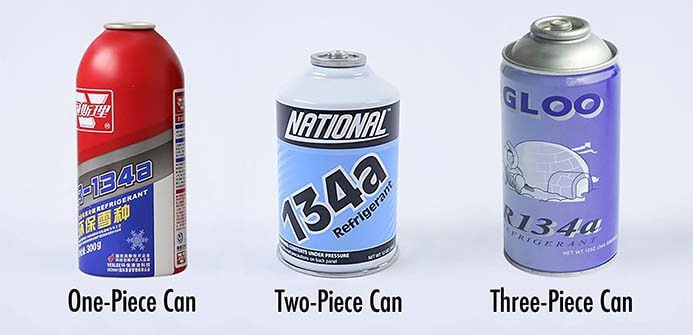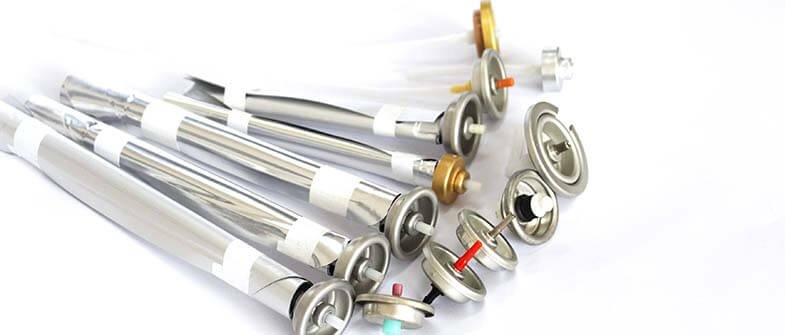Stop Using The Wrong Cans for Aerosol Refrigerant
08/05/2020Aerosol packaging first appeared in the U.S. market in the mid-1940s.
With the continuous development of aerosol products, aerosol packaging is gradually emerging in various countries.
Aerosol cans are used heavily in construction, food, medicine, and household applications.
1. Types of Aerosol Cans
According to the structure of the can, aerosol cans are divided into 3 main categories: one-piece can, two-piece can and three-piece can. See the below picture.

One-piece cans, also known as aluminum cans, are used in large numbers in the cosmetics and food packaging industries. It uses aluminum alloy sheet as the material, and the thinning and stretching process is used in the manufacturing process. So the thickness of the can wall is significantly thinner than the can bottom.
Once iron valves are applied, the internal pressure will deform the can mouth as one-piece can is crimped. This is because the can and the valve are 2 different metals of rigidity and strength. And it will result in many problems: inside contents leakage possibility; the impossibility of pressure relief device setting on the can.
The three-piece can has been in use for nearly 200 years. Traditionally, it consists of 3 parts: the body, the top and the bottom of the can.

Despite numerous improvements, the basic structural form of the can, consisting of three sheet metal plates for the body, bottom and lid, has not changed significantly.
Usually the metal sheet as the material is processed by crimping, bonding and resistance welding to form the can packaging container.
The advantages of three-piece cans are a wide range of applications, low cost, simple manufacturing process, and the cost of can-making equipment is within controllable limits.
But the downside of the three-piece can is also very noticeable, with weak pressure resistance because of the can seams.
The two-piece can was developed in the 1950s, and the development of modern processes has made it widely used in the daily chemical industry.

Its structure consists of the can body and bottom, so called two-piece can.
The tinplate metal sheet is stretched through the die by a punch, which is deformed by the stretching, so that the bottom and body of the can are united.
So the bottom and side walls of the two-piece tank are one piece, without the roll seal seams that the side walls of the traditional three-piece combination tank have with the bottom.
It is these structural features that make it easy to modify the upper and lower edges of the can body with appropriate processing, both to improve the structural strength of the two-piece can and to make the shape of the cylindrical container more beautiful.
The bottom of the can primarily serves to support the entire vessel, and is dominated by a domed shape.
The lower edge section is where the side wall meets the bottom of the can. It is often designed to fit with the foot of the can to ensure that the two-piece can has sufficient structural strength and proper exterior styling.
In addition, the bottom of the tank can be made into a pressure relief device (see picture below).

When the pressure inside the can rises steeply due to compression at a certain temperature and on the outside, a pressure relief device installed at the bottom of the can, where the stress is weakest, can relieve the pressure, thus protecting the life of the user.
Two-piece cans have the following advantages over three-piece cans.
1). Good sealing.
The most important feature of the two-piece can is the absence of seams on the side walls and bottom of the can and the integrity of the inside walls of the can.
At the same time, there is a complete internal coating protection, eliminating the possibility of leakage of the can body weld and bottom lid roll seal, overall good dense, to ensure the quality of the medium inside the can.
2). High security.
The overall strength of the two-piece can is much higher than that of the three-piece can due to structural reasons, with outstanding pressure resistance, and can be well adapted to the saturated steam pressure above 3.0MPa.
3). Good printing effect.
The two-piece can body has no seam, beautiful shape, and can be printed in full, convenient for the designer to design beautiful logo and pattern. And the can body can be continuously printing decorated with good effect.
4). High production efficiency.
Two-piece cans have only two parts, no welding process. The production process requirements are simpler than three-piece cans, and the consistency of the can body manufacturing process is easy to achieve.
However, two-piece cans also have drawbacks: their requirements for material properties, can-making technology, can-making equipment, etc. are relatively high.
2. Use of Refrigerant Aerosol Cans
Refrigerant is a special class of aerosol products. It is both an effective liquid and a propellant, but also a liquefied gas.

Currently there are more substances that can be used as refrigerants, such as liquid ammonia, chlorofluorocarbons, hydrochlorofluorocarbons, hydrofluorocarbons, etc.
The Montreal Protocol provides a restrictive phase-out of the use of the refrigerant Freon.
After 2005, the transition from CFC-12(R22) to HFC-134a began. At present, most of the refrigerants for vehicles are specified as R134a.
According to international classification standards, refrigerants are divided into 2 main categories according to their flammability, one is non-flammable and the other is flammable. For flammable refrigerants, there shall be specific requirements for the packaging of the refrigerant.
The internationally common means of testing aerosol can products is the water bath test. The finished aerosol cans are tested in water at a specific temperature of 55 ℃ to check whether the aerosol cans of the finished product will be deformed or leak at this temperature.

1.5 times the saturation pressure at 55 °C will be used as an indicator to differentiate between high and low pressure refrigerants. Refrigerants above 1.8 MPa are high pressure refrigerantss and those below 1.8 MPa are low pressure refrigerants. For high-pressure refrigerants, there must be a specific corresponding container requirement.
At present, China and some countries do not have a mandatory representation of the above 2 pressures for refrigerant metal containers and packagings, but have been using the standard for aerosol cans.
The first standard specifies a deformation pressure of 1.8 MPa or more and a burst pressure of 2.0 MPa or more.
The deformation pressure specified in the second standard is greater than or equal to 1.2 MPa and the burst pressure is greater than or equal to 1.4 MPa.
2 standards specify different pressures.
In fact, the pressures specified in both standards do not meet the actual demand. In the case of R134a, the most common small can car air conditioning repair product on the market, there have been numerous accidents.

According to data from several refrigerant packaging companies in the industry, similar accidents occur every year, each resulting in different injuries and larger property losses.
One of the reasons for these accidents is that commercially produced three-piece cans are essentially not at the required pressure.
The two-piece cans meet the above two pressures, and the deformation pressure test data is already higher than the required 2.25MPa.
Thus, the application of two-piece cans for refrigerant is the most appropriate option.
3. Main Stream in The Future
In many countries like the United States, Canada, ect. have banned the use of three-piece cans for any refrigerant and all other small cans of flammable and explosive aerosol products.
Starting from the safety characteristics of refrigerant, choosing the right packaging container for aerosol cans has become an urgent task in the current regulated market.
At present, 4th generation refrigerants are being promoted in Europe and the United States, and 2,3,3,3-tetrafluoropropene (HFO-1234yf) with low global warming potential (GWP) has been used internationally to replace R134a refrigerants.
Since HFO-1234yf is flammable, the safety requirements will be higher. So the safety requirements for small cans will be higher.
Two-piece cans have unparalleled safety advantages compared to three-piece cans. Thus, the use of two-piece cans in the refrigerant industry will become mainstream in the future.
If you have any questions, please contact our engineers at info@dawsom.com
Recent Posts
-
2 Ways You Can Take to Avoid Aerosol Can Corrosion Leaks
 After many years of scientific research, it has been found that HFCs, which used to be used as aerosol propellants, have a certain destructive effect on the ozone layer, so the production of CFCs in Europe and the United States is restricted by law.
After many years of scientific research, it has been found that HFCs, which used to be used as aerosol propellants, have a certain destructive effect on the ozone layer, so the production of CFCs in Europe and the United States is restricted by law. -
23 Aerosol Propellant Losses Will Cost You Money and Ruin Your Plant
 Did you know that aerosol propellants can be lost in 23 places? It is not only the propellant gas and money that are lost, but also the possibility of destroying the plant. Since there is almost no way to monitor and measure the use of propellants, it is very easy to lose them
Did you know that aerosol propellants can be lost in 23 places? It is not only the propellant gas and money that are lost, but also the possibility of destroying the plant. Since there is almost no way to monitor and measure the use of propellants, it is very easy to lose them -
9 Key Factors to Consider will Make You Select the Right Aerosol Valves
 Aerosols have played an important role in people's daily lives since their invention, production and application in the 1920s. It has a wide range of applications, such as personal care, household care, pest control, medical solutions, industrial care and food, etc., bringing great convenience to human life.
Aerosols have played an important role in people's daily lives since their invention, production and application in the 1920s. It has a wide range of applications, such as personal care, household care, pest control, medical solutions, industrial care and food, etc., bringing great convenience to human life.
Maximize Your ROI
by Investing in Our Cost-Effective Aerosol Filling Machines.
Contact Us
Copyright© 2019 Dawsom Mechanical & Electrical Co., Ltd. All Rights Reserved.



